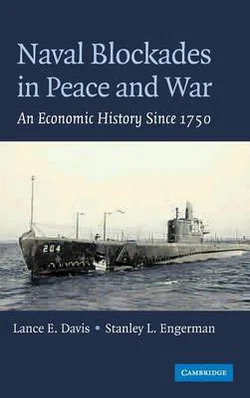
Naval Blockades in Peace and War; An Economic History Since 1750. By Lance E Davis and Stanley L Engermann. Cambridge University Press, New York, 2006 paperback edition, 2012
Reviewed by Tim Coyle
Naval blockades are commonly envisaged as ships from a combatant nation loitering beyond the far horizon, scrutinising merchantmen approaching ports, or enroute on the high seas, prepared to interdict, board and inspect for war materials, contraband or other sanctioned goods destined for an enemy or sanctioned entity.
Naval Blockades in Peace and War examines blockades of the United States versus Britain, 1776-1815, the Union against the Confederacy, World Wars One and Two and Blockades without War, including sanctions. At the time of writing, Lance E Davis (1928-2014) was Professor of Social Science at the California Institute of Technology and Stanley L Engermann (b. 1936), was Professor of Economics and History at the University of Rochester.
The book stemmed from the authors’ initial interest in the Civil War Union blockade of the Confederate states. They queried whether, or not, blockades of the preceding two centuries had similar effects. They found there was a considerable body of international law, which changed and adapted over time with strategic circumstances and military priorities. Additionally, they discovered source material in ‘Pacific blockades’ (measures used in peacetime to achieve specific ends without recourse to military action) and sanctions. What emerged in Naval Blockades in Peace and War is a scholarly treatise on international blockade law, sanctions and operational implementation. As a historical study, it has on-going relevance to maritime and air enforcement of current national- and United Nations-imposed sanctions and what form future blockades may take.
As a general introduction to the theory of blockade, the authors posit key factors dependent on the blockading power’s domestic and military resources and the geographic characteristics of the area of operations: the economy of the blockaded power must be vulnerable and the blockading power must have sufficient military resources to control the sea (and air) lines of communication to stifle import and exports. The book’s chapter on The American Submarine and Aerial Blockade of the Japanese Home Islands illustrates that Japan had been ‘driven back from her imperial outposts to the limited economic base of the Home Islands and Korea’.
The chapter on International Law and Naval Blockades in World War 1 discusses the initial US resistance to the British distant blockade in interdicting neutral ships for war contraband; the US view was cargoes should proceed unmolested in neutral American vessels. This view changed upon US entry into the war in 1917, aggravated by the German unrestricted submarine campaign of which the Lusitania sinking figured prominently. The sinking caused the campaign’s suspension until reinstatement in February 1917. The British distant blockade of Germany effectively starved that nation by war’s end and the counter-blockade by German submarines was only blunted by the Admiralty’s reluctant late adoption of the convoy system.
Post-war, the allied navies lost awareness of the potential of the submarine. Both Britain and the US waffled about possibly banning the submarine at the 1922 Washington Conference, while naval staffs planned to use them as fleet scouts and to support battle fleets. Again, it was Germany, in World War Two, which reprised the submarine with devastating effect until allied ‘hunter/killer’ groups including escort carriers and improved electronic warfare and weapons again subdued them (although German technological development might have seen a resurgence in the U-boat had it not been for the German capitulation). The US submarine campaign against Japan was successful, only after overcoming the deficiency in American torpedoes which rendered the US submarine force largely ineffective until late 1943. This scandal, discussed in the book, was only resolved by the submarine operators proving, against strong bureaucratic opposition, that the torpedoes were faulty.
Oddly, the book does not discuss the US Navy’s blockading action against Soviet shipping in the 1962 Cuban missile crisis. US ships intercepted Soviet merchant ships and tracked Soviet submarines, remaining on station through underway replenishment for a month-long naval quarantine of Cuba. This action was coordinated with air defence assets providing a complete combat, surveillance and intelligence collection operation which dissuaded the Soviet Union from continuing the missile placement in Cuba. This crisis is still regarded as the closest the world has come to nuclear war.
Naval Blockades in Peace and War is a serious academic work supported by numerous data tables. It offers extensive coverage of the laws of blockade through the ages as well as commentary on political and naval strategic deliberations and operational effectiveness.
Recent China People’s Liberation Army naval and air demonstrations against Taiwan, following high profile US political visits, have led to some commentators suggesting blockade may be a tactic the PLA might implement to ‘wear down’ Taiwanese defences and weaken its economy, thus avoiding a major war. Any serious study of how such a contingency might play out would benefit from a close reading of Naval Blockades in Pearce and War to assess the historical precedents and how these might apply in this 21st century contemporary instance.



